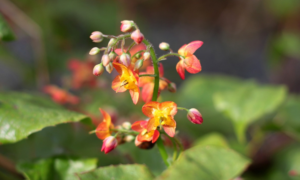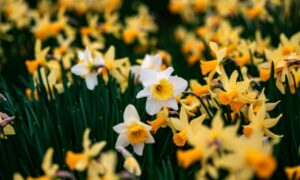We independently research, review, and recommend the best products. If you buy something through our links, we may earn a commission. Learn more.
Whether you have a small patio or a couple of acres, adding a flower garden can add colour, beauty, and a touch of nature to your outdoor space. But you already knew that.
Here I’ll take you through my 10-step apparoch to creating a stunning, affordable and easy-to-maintain flower garden, all based on my own experiences.
Let’s get to it.
Contents
1. Choose a location for your flower garden
Firstly, look for a spot that gets plenty of sunlight, as most flowers need at least 6 hours of sunlight per day. You should avoid areas with standing water or heavy shade, considering the growing conditions in your region, such as the climate, soil type, and amount of rainfall. Choose flowers that are suitable for those conditions, and consider whether you want annuals or perennials.
Annuals will bloom for one season and then die, while perennials come back year after year. Some examples of annual flowers that are easy to grow and add lots of colour include marigolds, zinnias, and impatiens. Low maintenance perennial flowers that are sure to stand out in your garden include daylilies, hostas, and black-eyed Susans.
2. Decide on a design
Think about the overall look and feel you want for your flower garden. Do you want a formal or informal style? Do you want a clean-cut bed with straight lines, or a more natural look? Consider the size and shape of your garden space and choose a design that will work well within those constraints.

Group plants with similar water and soil needs together, and use various plants to create visual interest and balance in the garden. You can find inspiration for garden design by looking at pictures online or in gardening magazines, or by visiting public gardens in your area.
Some design ideas to consider include a cottage garden with a mix of annuals and perennials in a free-flowing style, a formal parterre with geometric shapes and symmetry, or a pollinator garden with a variety of flowers that attract bees, butterflies, and other pollinators.
3. Prepare the soil
To give your flowers the best start, it’s important to prepare the soil properly. Begin by removing any weeds and debris from the area. Then, loosen the soil with a garden fork and add compost or well-rotted manure to enrich the soil. If you have heavy clay soil, consider adding some sand to improve drainage. If you have sandy soil, add some compost to help retain moisture.
Test the pH of your soil with a soil testing kit to determine if it is acidic, neutral, or alkaline. Some flowers, such as azaleas and rhododendrons, prefer acidic soil, while others, such as lavender and yarrow, prefer alkaline soil.
4. Select your flowers
Once you have a design in mind, it’s time to choose your flowers. Consider the colour scheme you want and choose flowers that will complement each other. Keep in mind the growing conditions in your area and choose flowers that are suitable for your climate.
Don’t be afraid to experiment and try out different varieties – you can always move or replace plants if they don’t work out. Some flowers to consider based on their colour include:
- Red: Red roses, red hot poker, red salvia
- Orange: Marigolds, nasturtiums, calendulas
- Yellow: Sunflowers, black-eyed Susans, coreopsis
- Pink: Peonies, hollyhocks, foxgloves
- Purple: Lavender, irises, alliums
5. Purchase your flowers and other materials
Once you’ve chosen your flowers, purchase them from a reputable nursery or garden centre. You’ll also need other materials, such as mulch, compost, and planting tools. Don’t skimp on quality – it’s worth investing in good soil and compost, as well as sturdy tools that last through the seasons.
Some tools you’ll need include a garden fork, shovel, trowel, and pruning shears. If you’re planting a large area, you may want to invest in a wheelbarrow or garden cart to make it easier to transport materials.
6. Plant your flowers
Follow the instructions on the plant labels and place your flowers at the appropriate depth and spacing. Water them well and mulch around the base of the plants to help retain moisture and suppress weeds.
If you’re planting a mix of annuals and perennials, consider planting the perennials in the back or centre of the bed, with the annuals in front to provide a burst of colour.
When planting, be sure to loosen the roots gently and free the soil around the plant. Water the plant well to help it get established.
7. Fertilise your flowers
To keep your flowers healthy and blooming, fertilise them regularly. Use a balanced fertiliser or a fertiliser specifically formulated for flowers. Follow the instructions on the label for the proper amount and frequency.
For annuals, you may need to fertilise every couple of weeks, while perennials may only need fertilising once a month. Avoid over-fertilising, as this can lead to leggy plants with fewer blooms.
8. Deadhead your flowers
As your flowers begin to open, be sure to deadhead them by removing spent blooms. This will encourage new growth and more blooms. Simply snip off the faded flowers at the base of the stem, using scissors or pruning shears.
9. Protect your flowers from pests
Keep an eye out for pests, such as aphids and slugs, and take steps to control them if necessary. You can use organic methods such as neem oil or insecticidal soap, or use chemical pesticides as a last resort.

Check your plants regularly, and take action as soon as you notice any signs of pests.
10. Maintain your flower garden
Regularly water your flowers and weed the garden to keep it looking its best. In autumn, cut back your annuals and prepare your perennial flowers for winter. This may include mulching the plants to protect them from extreme temperatures, or cutting back dead foliage to make room for new growth in the spring.
Don’t be afraid to prune your plants – it may seem counter productive, but pruning can actually help your flowers grow healthier and more vigorously.
So that’s it! Following these 10 steps, you can create a beautiful flower garden that will add colour and style to your outdoor space. Gardening is a rewarding hobby that can provide enjoyment, relaxation, and a sense of accomplishment. So grab your gloves and get started!








